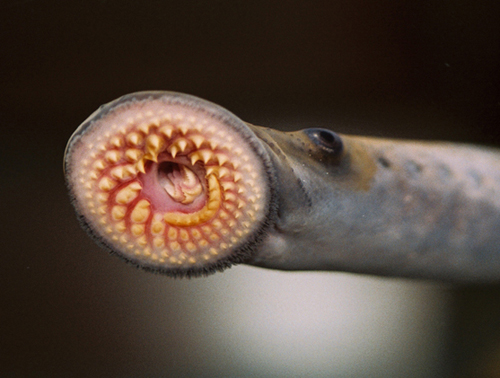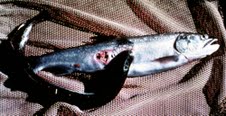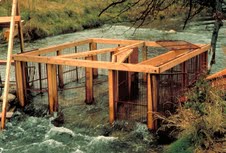
Interactions
 The
relationship between sea lamprey and other fish species is a
parasitic symbiotic relationship. A parasitic relationship is
where one species gains something and the other species is
harmed. The sea lamprey is considered the parasitic fish because
they are the species that is gaining; they attach themselves to
other species of fish with their many sharp teeth and drain the
host fish of its body fluids (Cherry, 2011). The host fish
typically die because of blood loss or infections. They could
not die from a blood clot because the anticoagulant in the
saliva of the sea lamprey keeps the blood thin. If the host fish
does survive, their reproduction has decreased. Some host fish
of the sea lamprey vary from salmon, whitefish, walleye,
northern pike, burbot, lake trout, rainbow trout, chubs, some
catfish and lake sturgeon (Cherry, 2011; New York Department of
Environmental Conservation, 2013; Smith & Tibbles, 1980).
Another fish sea lamprey are parasitic to are
paddlefish. No research has shown that sea lamprey have
particular favorites in their host of choice. If you would like
a better understanding of how parasitic relationship work click
on these examples,
tooth decaying bacteria and
Aspergillus flavus (fungi). P. marinus, Sea Lamprey, have a
commensal symbiotic relationship with other parasitic flatworms
and roundworms. In a commensalistic symbiotic relationship
neither species is affected by the other. Commensalism could be
considered “neutral ground” (Cherry, 2011). Another interaction
sea lamprey have is with humans.
The
relationship between sea lamprey and other fish species is a
parasitic symbiotic relationship. A parasitic relationship is
where one species gains something and the other species is
harmed. The sea lamprey is considered the parasitic fish because
they are the species that is gaining; they attach themselves to
other species of fish with their many sharp teeth and drain the
host fish of its body fluids (Cherry, 2011). The host fish
typically die because of blood loss or infections. They could
not die from a blood clot because the anticoagulant in the
saliva of the sea lamprey keeps the blood thin. If the host fish
does survive, their reproduction has decreased. Some host fish
of the sea lamprey vary from salmon, whitefish, walleye,
northern pike, burbot, lake trout, rainbow trout, chubs, some
catfish and lake sturgeon (Cherry, 2011; New York Department of
Environmental Conservation, 2013; Smith & Tibbles, 1980).
Another fish sea lamprey are parasitic to are
paddlefish. No research has shown that sea lamprey have
particular favorites in their host of choice. If you would like
a better understanding of how parasitic relationship work click
on these examples,
tooth decaying bacteria and
Aspergillus flavus (fungi). P. marinus, Sea Lamprey, have a
commensal symbiotic relationship with other parasitic flatworms
and roundworms. In a commensalistic symbiotic relationship
neither species is affected by the other. Commensalism could be
considered “neutral ground” (Cherry, 2011). Another interaction
sea lamprey have is with humans.
Humans are their most common and known predator for this
parasitic fish (Cherry, 2011). Humans typically will eat them in
their food or try kill them off because of sea lamprey’s harmful
effects on other fish populations. In other countries, like in
Europe, Asia and India, people will use them in their cooking
(Cherry, 2011). There have been many examples in places like the
Great Lakes and other places in the United States where people try
to kill sea lamprey off. This situation typically occurs when the
sea lampreys decrease a fish population because they are also
affecting the industries that would be selling those fish. An
example close to home is from the 1930’s to 1980’s in the Five Great
Lakes. It is said that sea lamprey species came into the Great Lakes
in the 1930’s and by the 1940-50’s they had significantly decrease
the fish populations in these lakes, especially Huron, Michigan and
Superior (Smith & Tibbles, 1980). By the early 1950’s humans decided
these parasitic fish need to be stopped. They tried electric
barriers and used the toxin lampricide
3-trifluoromethyl-4-nitrophenol (TFM), which was used to destroy
larval lampreys in streams (Smith & Tibbles, 1980). Between the two
of these factors the population of the sea lamprey decreased and the
population of other fish species increased. To keep the population
of sea lamprey to a minimum there have been federal and state
programs and treatments created.

Within the Great Lakes region a small amount of sea lampreys have been found carrying flat or roundworms for a portion of their life (Cherry, 2011). This is important because sea lamprey are bringing more invasive species into ecosystems where they could affect the fish populations. Roundworms were also causing harm to species of fish, not including sea lamprey (Cherry, 2011). The Great Lakes is not the only place that sea lamprey are harming fishing industries. Sea lamprey are considered native, or not considered an invasive species, on the Atlantic coast of North America (New York Department of Environmental Conservation 2013). Petromyzon marinus kill more than 18.2 kg of fish annually; this has caused fishing industries millions of dollars and is negatively affecting the “sport” of fishing and tourism (Cherry, 2011). For all of these reasons, sea lamprey are unprotected and there are programs from state and federal governments that educate people about the sea lamprey species and of treatments that dispose of the sea lamprey specifically (New York Department of Environmental Conservation 2013).
To find more information about this visit the USGS website.